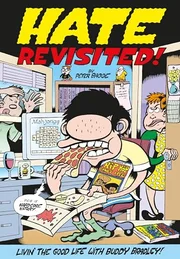
The book alternates between the characters’ young adulthoods in 1990s Seattle (in black and white) and their middle-age years in the 2020s in the suburbs of Seattle and New Jersey (in color). We see the formative moments of a group of disaffected friends—maybe just associates—and how life has changed or broken them. Central figure Buddy begins as a sarcastic rabble-rouser who teams up with his trouble-making and troubled roommate, Stinky, to ruin an indie label showcase at a record store. The next day, Stinky tells George, their new roommate (who is Black and antisocial while the others are white), that Buddy is a racist, which Buddy doesn’t deny. In the present, many people, including Buddy’s wife, Lisa (who met Buddy the night of the record store event and helped ruin it), suspect Buddy of being a MAGA supporter, which he denies—without supporting Democrats. Mostly Buddy just hates everything, except his family. Bagge presents loosely connected vignettes featuring a large cast of characters in Buddy’s orbit, which pays off more for longtime Hate fans than for casual readers, but seeing the past’s echoes in the present delivers a pleasing symmetry. This is exemplified when Buddy and Lisa worry about their son befriending an unhoused person and casual thief named Spam; after some amateur sleuthing, they discover Spam’s real name is Leonard, which was also the real name of Stinky, who was an aggressive thief with a taste for weapons and probably more trouble than he was worth as a friend. Bagge keenly and humorously observes our divided and divisive culture, grounding the work in his affinity for family. His art is elastic and expressive, and the colored pages are rich and sumptuous.


